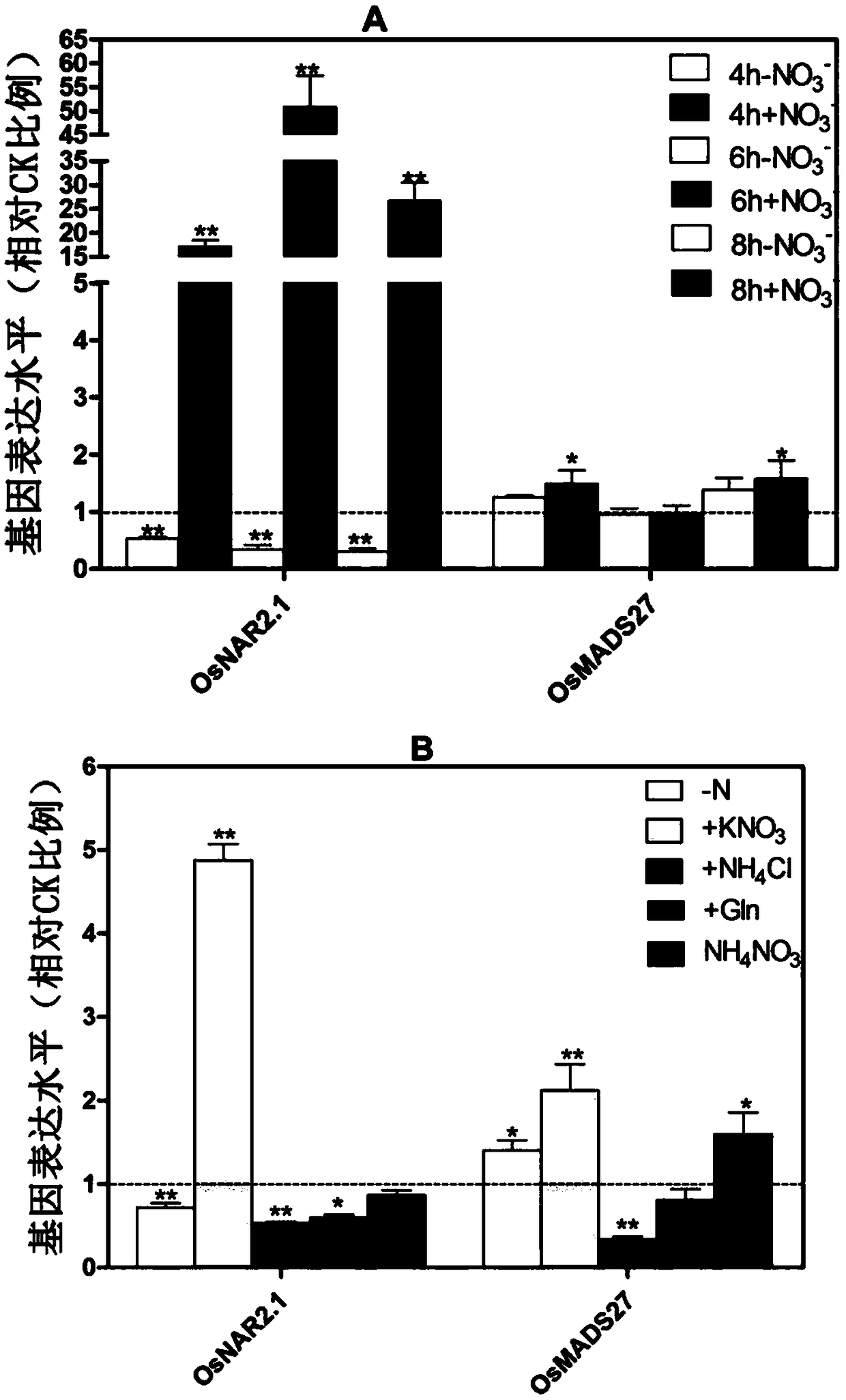Application of rice OsMADS27 gene and protein in improving nitrogen fertilizer use efficiency of rice
A utilization rate and rice technology, applied in the fields of application, genetic engineering, plant gene improvement, etc., can solve the problems of nitrogen fertilizer utilization resource waste, water eutrophication pollution, and lower nitrogen use efficiency, so as to promote expression, transport and The effect of absorbing and improving nitrogen utilization efficiency
- Summary
- Abstract
- Description
- Claims
- Application Information
AI Technical Summary
Problems solved by technology
Method used
Image
Examples
Embodiment 1
[0025] Cloning of the rice OsMADS27 gene.
[0026] (1) Extraction of total RNA. From rice (Nipponbare) seedlings to the 3-leaf stage, take the roots of the rice seedlings and put them in liquid nitrogen for quick storage, weigh about 0.1g of roots, grind them with liquid nitrogen, put them into a 1.5ml centrifuge tube after grinding, and quickly add TRIzol reagent (purchased from Invitrogen Company) was shaken thoroughly, and the total RNA was extracted.
[0027] (2) Synthesis of cDNA.
[0028] The first strand of cDNA was synthesized using the M-MLV reverse transcription system (Takara code: D2639A), the steps are as follows:
[0029] RNA 1-2μg
[0030] Oligo d(T)18 Primer (50μM) 2μl
[0031] RNase-free H 2 O make up to 10 μl
[0032] 70 ℃ water bath for 10 minutes, placed on ice for 2 minutes to cool. Centrifuge for a few seconds to pool the template RNA / primer / water denaturing solution at the bottom, then add:
[0033]
[0034] Incubate at 42°C for 1h. Incubate ...
Embodiment 2
[0047] OsMADS27 gene interference vector construction and genetic transformation.
[0048] (1) Construction of RNAi expression vector
[0049] The cDNA sequence of the OsMADS27 gene was compared with the rice full-length cDNA database, the 200-300bp fragment of the non-conserved region was selected as the interference fragment, and the primers were designed with the interference fragment as the target interference sequence. The vector used was pTCK303, and primers were designed using Primer Primer 5.0 software as follows:
[0050] RiOsMADS27-FP:
[0051] 5'-GCGACTAGTGGTACCGAATCGGAAGGGAAGTCTAG-3';
[0052] RiOsMADS27-RP:
[0053] 5'-GCGGAGCTCGGATCCTTGTTCGGCGTCACTATGT-3'.
[0054] Using the cDNA of the rice root system in Example 1 as a template, carry out PCR amplification with the above-mentioned primers, and use the high-fidelity enzyme Prime HS DNA Polymerase (Takara Code: DR010A) system. Take 50 μl of PCR product and 5 μl of DL2000 DNA Marker (Takara Code: D501A), an...
Embodiment 3
[0064] OsMADS27 gene overexpression vector construction and genetic transformation.
[0065] (1) Construction of overexpression vector
[0066] With the cDNA of the rice root system in Example 1 as a template, the carrier used is pENTR 1A, and the Primer Primer5.0 software is utilized to design primers as follows:
[0067] OE-OsMADS27-FP:
[0068]5'-GCGGTCGACATGGGGAGGGGGAAGATTGT-3';
[0069] OE-OsMADS27-RP:
[0070] 5'-GCGCCATGGTCATGGATTCAACTGTAACC-3'.
[0071] After digestion and purification, the PCR product was connected to the vector pENTR 1A, and the sequenced correct primary vector was exchanged with the Gateway overexpression vector pH2GW7.0, using Gateway LR ClonaseTM Enzyme Mix (Invitrogen, Cat.No.11791-019), the system as follows:
[0072] 1) Add the following reagents to a 1.5ml centrifuge tube and mix well at room temperature:
[0073] Entry clone 50-150ng
[0074] Destination vector 150ng
[0075] TE buffer (pH=8.0) make up to 8μl
[0076] 2) Take LR Clon...
PUM
 Login to View More
Login to View More Abstract
Description
Claims
Application Information
 Login to View More
Login to View More - R&D Engineer
- R&D Manager
- IP Professional
- Industry Leading Data Capabilities
- Powerful AI technology
- Patent DNA Extraction
Browse by: Latest US Patents, China's latest patents, Technical Efficacy Thesaurus, Application Domain, Technology Topic, Popular Technical Reports.
© 2024 PatSnap. All rights reserved.Legal|Privacy policy|Modern Slavery Act Transparency Statement|Sitemap|About US| Contact US: help@patsnap.com










